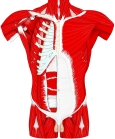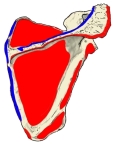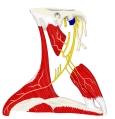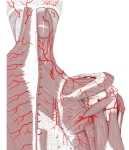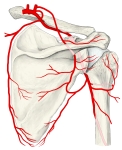僧帽筋 ( そうぼうきん、英:trapezius muscle )
・ 概 要 |
・ 作 用 |
・ イラスト掲載サイ |
|
・ イラスト |
・ 神経 / 脈管 |
||
・ 起始 / 停止 |
・ Wikipedia |
![]()

・ 和名は修道士がかぶるフードから由来する。
⇒ 名称の由来がなんとなく確認できる写真を掲載したサイトへのリンク)
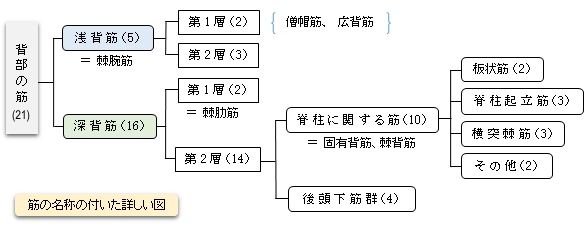

「 後頭骨と上位頚椎の棘突起付近の筋腹は薄い。」(日本人体解剖学)
![]()
下行部:上部に位置し、筋線維は下外側方に走る。身体の前部からでもその一部が確認できる。
横部:中部に位置し、筋線維はほぼ水平に外側方に走る。
上行部:下部に位置し、筋線維は上外側方に走る。
![]()
以下は 「 日本人体解剖学 」 の解説の一部となる。
「 腱 境:左・右両側の僧帽筋の起始腱の部位。第7頚椎くらいで最も幅広く、その上、上下は次第に狭くなり、全体として菱形の光った部分となる。」
【 変 異 】
「 船戸和弥のHP 」 の 「 Rauber-Kopsch解剖学 」 ではこの筋の解説において 「 変異 」 ということで以下のように解説している。
「 ( 日本人の僧帽筋の完全欠如に近い例が報告されている(狩谷慶喜:北越医学会雑誌, 51巻,1139~1142,1936).また鎖骨停止部の変異が胎児および新生児125体のうち5体,8側にみられた(山田迪:解剖学雑誌,7巻, 337~347,1934).)
筋の二分Zweiteilungは,中心腱膜の高さに見られるものが最も多い分岐の型である.筋の左右がわずかに非対称であることは,ほとんど毎常見られることである.筋起始の減少は,男性よりも女性にいっそう多く見られるという.極端に僧帽筋起始が減少している場合にはその上方はわずかにC. IVまで,また下方はTh. VIII, IX, Xまで存在するに過ぎない.鎖骨部を欠如することもある.過剰筋束は,時にこの筋の上部の前縁に見られ,これを鎖骨後頭筋束Fasciculi cleido-occipitalesといい,これが胸鎖乳突筋の鎖骨部に加わることがある.この筋束は,しばしば頭蓋骨に付着しないで上位頚椎の肋横突起に停止し,特に環椎に終ることが最も多く,これを鎖骨環椎筋M. cleido-atlanticusという.また三角筋と結合することもある. 」
![]()
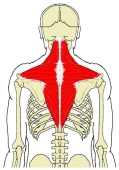 |
 |
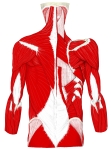 |
||
 |
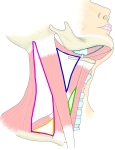 |
![]()
【 起 始 】 :
・ 後頭骨、上項線(または最上項線) ・後頭骨、外後頭隆起 ・ 項靭帯 ・ 第7頸椎と全胸椎、 棘突起
・ 棘上靭帯
※「日本人体解剖学」の僧帽筋の解説文の中には、「起始」として「後頭骨の上項線」の文字が見られるが、後頭骨の上項線の解説文の中には「僧帽筋」の名称は見られず、代わって「最上項線」の解説文の中に、「僧帽筋が起始する隆起線」という文章があり矛盾が見られる。
【 停 止 】:鎖骨部 : 鎖骨の外側方1/3 肩峰部:肩甲骨の肩峰 肩甲部:肩甲骨の肩甲棘

|
![]()
「日本人体解剖学 (上巻) 」では
全体として肩を後方に引く。また、上部のみが作用するときは肩甲部を挙上し、下部のみが作用するときはこれを下牽し、かつ肩甲骨下角を外側方に転ずる。上肢帯が固定しているときは両側が働くと頭を後方に、一側が働くと頭をその方向に引く。
「プロメテウス解剖学アトラス」では
・下行部:肩甲骨を斜め上方に引いて関節窩を下方に回す。(前挙鋸筋の下部筋束と協同して)
頭を同側に傾け、対側に回転させる。(上肢帯を固定させて)
・水平部:肩甲骨を内側に引く。
・僧帽筋全体:胸郭に対し肩甲骨を安定させる。
![]()
・ 神 経:副神経の外枝、頚神経叢の筋枝 (C2,C3,C4)
・ 脈 管:動 脈 ( 頸横動脈、肩甲上動脈、肋間動脈の背枝、深頚動脈、後頭動脈 )
静脈:動脈に準じる?
The trapezius is a large paired surface muscle that extends longitudinally from the occipital bone to the lower thoracic vertebrae of the spine and laterally to the spine of the scapula. It moves the scapula and supports the arm.
The trapezius has three functional parts: an upper (descending) part which supports the weight of the arm; a middle region (transverse), which retracts the scapula; and a lower (ascending) part which medially rotates and depresses the scapula.
【 語 句 】
・ longitudinally : 縦方向に ・ occipital bone : 後頭骨 ・ thoracic vertebrae : 胸椎 ・ spine of the scapula : 肩甲棘 ・ retract : 引っ込める
【 Structure 】
The superior or upper (or descending) fibers of the trapezius originate from the spinous process of C7, the external occipital protuberance, the medial third of the superior nuchal line of the occipital bone (both in the back of the head), and the ligamentum nuchae. From this origin they proceed downward and laterally to be inserted into the posterior border of the lateral third of the clavicle.
The middle fibers, or transverse of the trapezius arise from the spinous process of the seventh cervical (both in the back of the neck), and the spinous processes of the first, second, and third thoracic vertebrae. They are inserted into the medial margin of the acromion, and into the superior lip of the posterior border of the spine of the scapula.
The inferior or lower (or ascending) fibers of the trapezius arise from the spinous processes of the remaining thoracic vertebrae (T4–T12). From this origin they proceed upward and laterally to converge near the scapula and end in an aponeurosis, which glides over the smooth triangular surface on the medial end of the spine, to be inserted into a tubercle at the apex of this smooth triangular surface.
At its occipital origin, the trapezius is connected to the bone by a thin fibrous lamina, firmly adherent to the skin. The superficial and deep epimysia are continuous with an investing deep fascia that encircles the neck and also contains both sternocleidomastoid muscles.
At the middle, the muscle is connected to the spinous processes by a broad semi-elliptical aponeurosis, which reaches from the sixth cervical to the third thoracic vertebræ and forms, with that of the opposite muscle, a tendinous ellipse. The rest of the muscle arises by numerous short tendinous fibers.
It is possible to feel the muscles of the superior trapezius become active by holding a weight in one hand in front of the body and, with the other hand, touching the area between the shoulder and the neck.[citation needed]
【 語 句 】
・spinous process:棘突起 ・external occipital protuberance:外後頭隆起 ・superior nuchal line:上項線 ・ligamentum nuchae:項靭帯 ・clavicle:鎖骨 ・acromion:肩峰 ・aponeurosis:腱膜 ・apex:頂点 ・lamina:薄膜 ・epimysia:筋上膜 ・sternocleidomastoid muscles:胸鎖乳突筋 ・semi-elliptical:半楕円形の
【 Innervation 】
Motor function is supplied by the accessory nerve.[5] Sensation, including pain and the sense of joint position (proprioception), travel via the ventral rami of the third (C3) and fourth (C4) cervical spinal nerves.[5] Since it is a muscle of the upper limb, the trapezius is not innervated by dorsal rami, despite being placed superficially in the back.
【 語 句 】
・ motor function : 運動機能 ・ accessory nerve : 副神経 ・ proprioception : 自己受容性感覚 ・ ventral rami : 前枝 ・ dorsal rami : 後枝
【 Function 】
Contraction of the trapezius muscle can have two effects: movement of the scapulae when the spinal origins are stable, and movement of the spine when the scapulae are stable.[5] Its main function is to stabilize and move the scapula.[5]
・ Scapular movements
The upper fibers elevate the scapulae, the middle fibers retract the scapulae, and the lower fibers depress the scapulae.[5]
In addition to scapular translation, the trapezius induces scapular rotation. The upper and lower fibers tend to rotate the scapula around the sternoclavicular articulation so that the acromion and inferior angles move up and the medial border moves down (upward rotation). The upper and lower fibers work in tandem with serratus anterior to upwardly rotate the scapulae, and work in opposition to the levator scapulae and the rhomboids, which effect downward rotation.
An example of trapezius function is an overhead press. When activating together, the upper and lower fibers also assist the middle fibers (along with other muscles such as the rhomboids) with scapular retraction/adduction.
The trapezius also assists in abduction of the shoulder above 90 degrees by rotating the glenoid upward. Injury to cranial nerve XI will cause weakness in abducting the shoulder above 90 degrees.
・ Spinal movements
When the scapulae are stable, a co-contraction of both sides can extend the neck.
【 語 句 】
・ contraction : 収縮 ・ retract : 引っ込ませる ・ translation : ? ・ sternoclavicular articulation : 胸鎖関節 ・ serratus anterior : 前鋸筋 ・ levator scapulae : 肩甲挙筋 ・ rhomboid : 菱形筋 ・ adduction : 内転 ・ abduction : 外転 ・ glenoid : 関節窩 ・ cranial nerve : 脳神経
![]()



